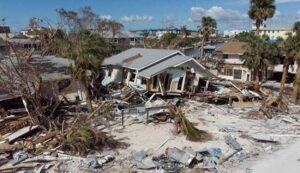US: Florida’s insurance market suffered huge losses
US: The damage of Hurricane Helene still affects Florida’s already taxed insurance sector, which is now under further strain as Hurricane Milton approaches the state.

According to Mark Friedlander, director of corporate relations at the Insurance Information Institute (Triple-I), Hurricane Milton is expected to be much more costly for insurers than Helene.
Based on present projections, Friedlander said Milton would most certainly be a “much larger windstorm loss event” than the previous three landfall Florida storms combined—Idalia in 2023 and Debby and Helene this year.
Property insurance usually covers damage resulting from winds; a flood insurance coverage covers damage resulting from floods.
Already paying the highest insurance rates nationwide are Florida residents. Data provided to Newsweek by the virtual insurance business Insurify shows that home owners in the state paid an average yearly premium of $11, 163 as of July 2024. At this point the national average premium was $2,435 annually.
Florida’s higher natural catastrophe risk has caused some of the explosive rise in these rates.
The degree of Helene’s devastation is still unknown; estimates of insured loss vary greatly.
Friedlander said Helene was a “moderate loss event” for Florida house insurers, with an anticipated cost of $1 billion to $2 billion, despite being a Category 4 storm.
He said that rather than wind, storm surge and riverine floods mostly caused the harm Helene brought about. For homeowners, this is an issue because, according to The Wall Street Journal, more than 95% of houses in Hurricane Helene’s route lacked flood insurance coverage.
Other estimates place Helene’s property damage higher. Lloyd’s of London’s chief executive, John Neal, told The Wall Street Journal that the insured loss would probably range from $5 billion to $15 billion.
It is not always apparent what qualifies as flood or wind damage, and conflicts between homeowners and insurers could lead to legal actions.
Homeowners claiming in the aftermath of Helene and Milton may also find difficulties since insurers have in recent years lowered coverage, increased deductibles, and tightened policy conditions to meet mounting financial constraints from increasing natural catastrophe underwriting losses.
Homes with small losses may suddenly discover that they are not covered due to these increased deductibles for things like wind damage.
Two consecutive natural catastrophes would surely strain Florida’s already precarious insurance industry.
“With Hurricane Milton, insurers’ claims teams that may already be taxed after Helene will be under further stress,” says Insurify’s vice president of carrier management and operations, Betsy Stella, told Newsweek.
“Insurers are hoping that they priced premiums to match this season’s risk,” she said. Still, it will be some time before they will know if that is the case. What we know is fraud, storm-chasing contractors, and exaggerated price of replacement supplies will influence the market. All of this will probably raise claim expenses and future rates might be driven higher as well.
Friedlander sees things from a less negative standpoint. According to him, the Florida property insurance market is “well-positioned to act as financial first responders” to its clients affected by Hurricane Milton this week.
“State legislative reforms in 2022 and 2023 addressing the man-made factors which caused the Florida risk crisis—legal system abuse and claim fraud—are helping the market to be in its best financial condition in many years,” he added.
According to Erin Collins, senior vice president of state and policy affairs for the National Association of Mutual Insurance Companies, “while Milton is expected to make landfall as a major hurricane, it’s too early to tell the financial toll it will take.”
Following Helene, further damage might put more strain on the regional market for repairs.States like Florida might experience many hurricanes in one season, and many coastal towns are still expanding, so it emphasizes the need of improving state insurance markets.”
As insurers are expected to witness an avalanche of claims and homeowners may find their insurance coverage inadequate or see their rates climb even more in the future, it is yet to be seen how the market will handle the twin blow of two consecutive storms.